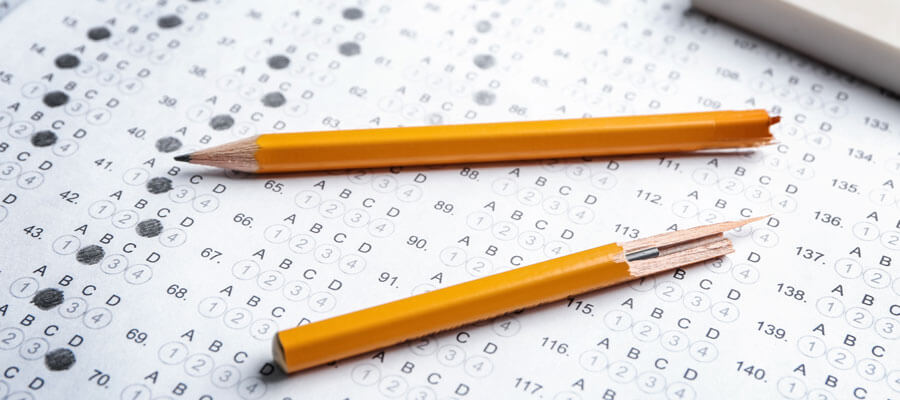
The move from a paper-and-pencil SAT to a digital, adaptive SAT is one of the biggest changes the test has seen in its 100-year history. As of the March 2024 SAT, bubble sheets will be a thing of the past. For U.S. students, the October 2023 PSAT was their introduction to digital testing.
Compass is leading the adoption of digital testing in the test preparation space. Our product team has been, for some time, in conversations with executives from College Board and ACT about their respective plans and what those plans mean for students. Compass already has digital adaptive PSAT and SAT practice tests available as well as extensive online homework for tutoring and group instruction students.
The Short Version:
- SAT’s tact is to change with the times and move testing to computers and tablets. The test will also be shorter and adaptive.
- ACT’s strategy is to stay with traditional paper-and-pencil testing. Even as the organization makes tentative moves toward computer-based testing, ACT has vowed to keep the traditional option available.
- The new terrain looks as transformed as anything the test prep industry has previously navigated. It will require more resources, institutional experience, technical expertise, and specialization than ever before to properly respond to the needs of the market. Compass is ready, and our students will be, too.
- Almost all students in the class of 2024 will finish their testing before the arrival of the digital SAT.
- The class of 2025 is the first U.S. class to be confronted by the PSAT and SAT’s move to a digital, adaptive format.
Rollout Timeline
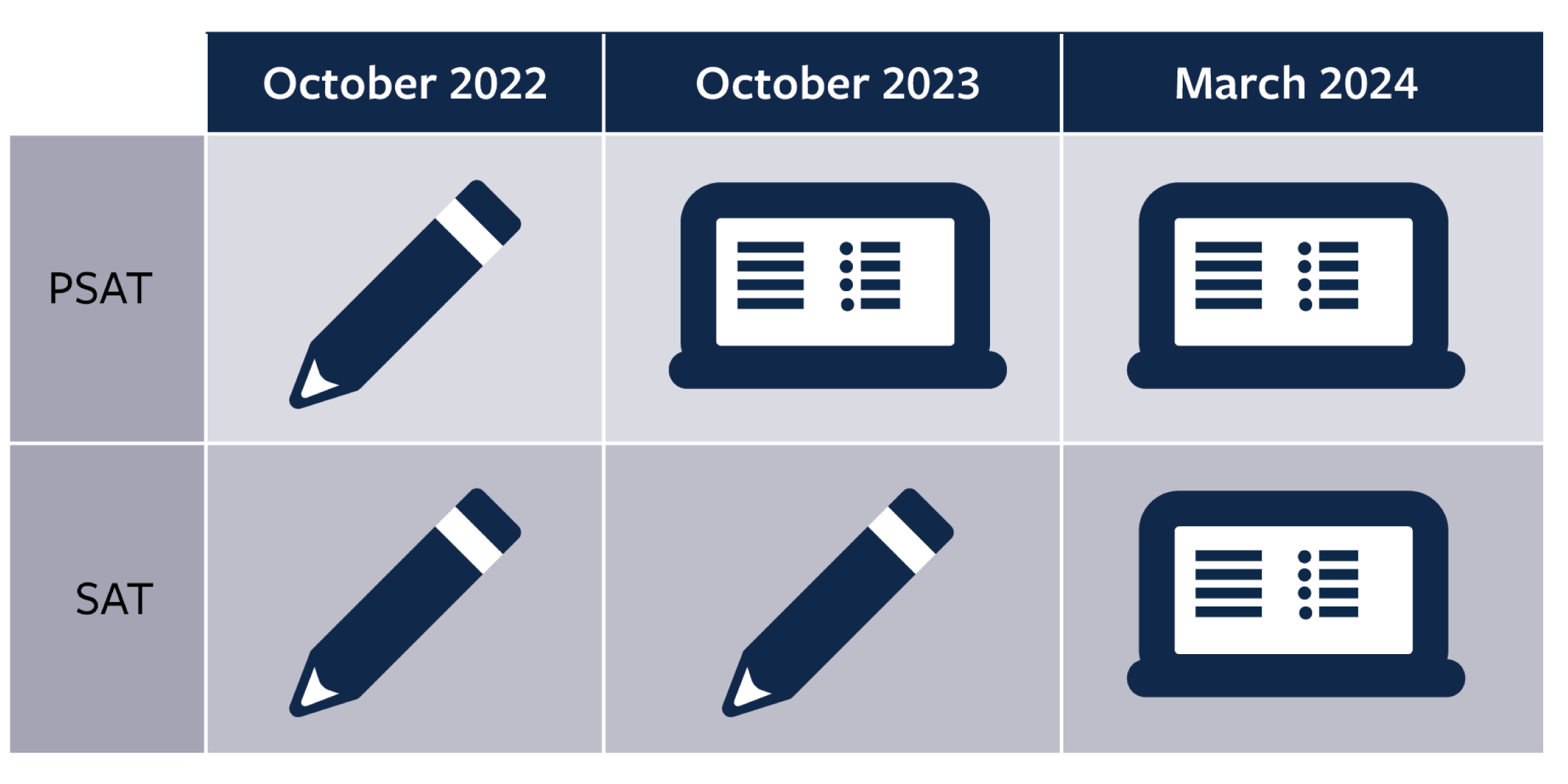
College Board offered an international digital SAT in March 2023. In the U.S., the PSAT changed to digital in October 2023, with the SAT following in March 2024.
- Test specifications are available here.
- College Board’s Bluebook practice testing app is now available with four practice SATs. A PSAT 8/9 and a PSAT/NMSQT are also available. More tests will be released over time.
- Khan Academy has released an initial set of practice materials.
- Students, high schools, and colleges will not need to learn new scoring. College Board will continue with 200-800 scoring, and no concordance is needed. A 620 on a paper test is meant to equate to a 620 on the digital SAT.
- There is every indication that colleges will superscore across paper and digital SATs.
Differences Between the New Digital SAT and Paper Tests: Overview
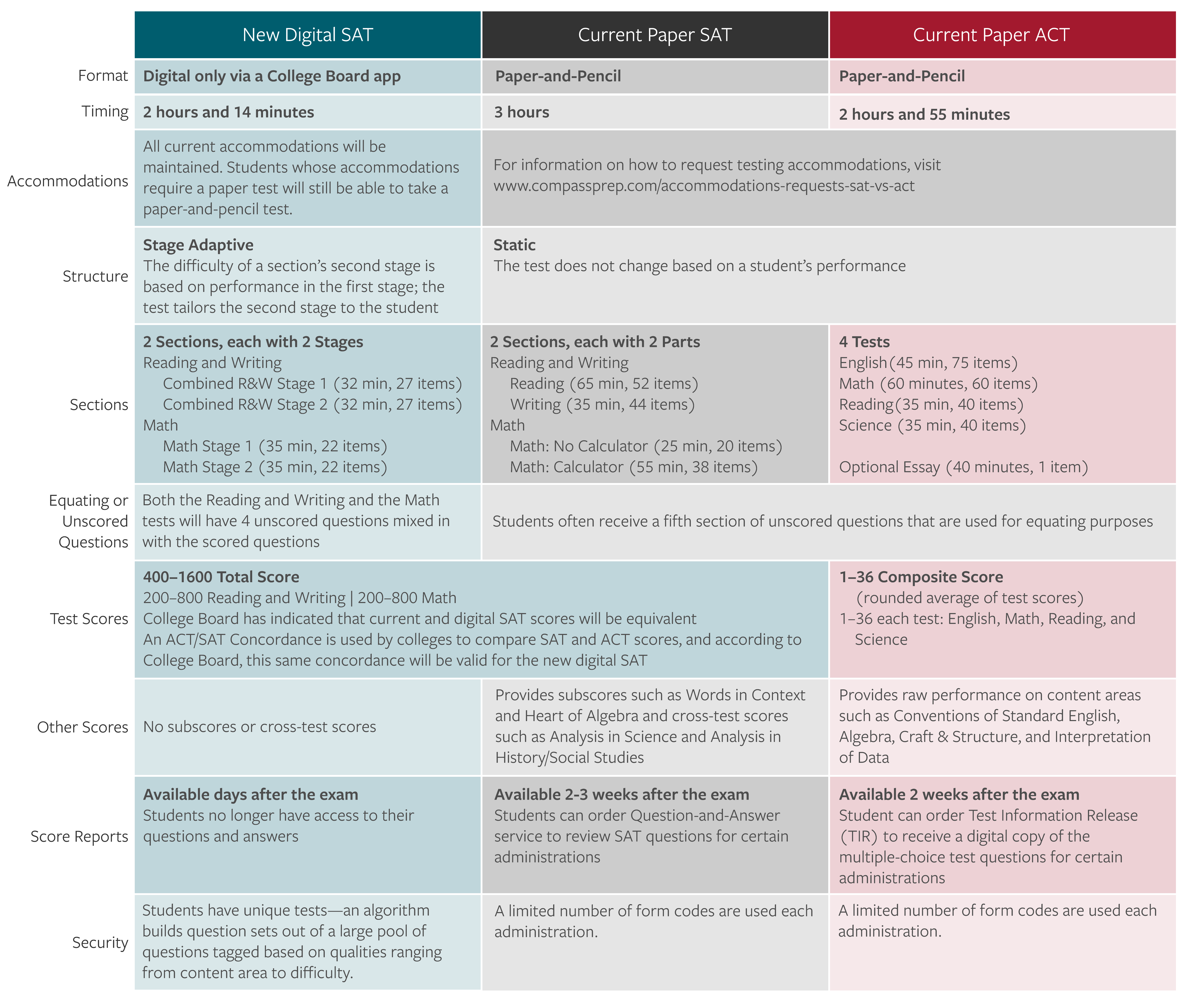
Editor’s note about Score Reports: College Board has stated scores for the digital test will be available within “days” of the exam, but so far the actual test score return dates have mirrored what was seen with paper testing.
Details on the Digital, Adaptive SAT:
Administration
- National dates will remain unchanged for now. Spaces may be limited in some areas; we recommend registering early.
- School day testing will enjoy even greater flexibility: broad testing windows, staggering students throughout the day or across a week or month. Easy make-ups for absences. However, there will be limits to re-testing within a window.
- National testing could eventually offer more flexibility: staggered start times throughout the day, for example.
- This is not an at-home exam. Students will test at school or a testing site.
- Students have many options for testing devices. They may use their own laptops (Windows or MacOS), iPads, school-owned desktops and laptops, and school-managed Chromebooks.
- Bandwidth requirements are minimal. The entire test is cached and encrypted, so an internet disruption should not prevent the completion of an exam. The exam results can even be uploaded after the test has already been completed. When a proctor says, “Pencils down,” on a paper test, it is difficult to enforce securely. The computer can easily end the student’s exam and keep the results secure.
Accommodations
- Existing accommodations will be maintained and most will be provided in the digital, adaptive format.
- Students with extended time will not be allowed to end a section early to advance.
- For accommodations that cannot be provided digitally (e.g., Braille), students will take a longer, 3-hour, non-digital and non-adaptive exam.
Stage Adaptive, The Basics
- The adaptive nature of the exam is essential to making it a much shorter test—cutting testing time by one-third.
- When a student connects the app to the internet and starts a test, the app downloads three sets of questions (modules) per section to the testing device.
- Each section is broken into two stages:
- Reading & Writing contains two stages of 27 questions in 32 minutes
- Math contains two stages of 22 questions in 35 minutes
- All students take the test in the following order: Reading & Writing Stage 1, Reading & Writing Stage 2, Break, Math Stage 1, Math Stage 2
- The SAT is not item-adaptive, where every question varies based on performance (like the GMAT). Rather, it is stage-adaptive (like the GRE). It will only adapt once for Reading & Writing and only once for Math. This lowers the stakes on any one question and also preserves the ability to go backward and forward within a stage.
- The first stage of each section is not adaptive (item difficulty will not “adapt” to a student’s performance) and it contains a full range of question difficulty.
- At the end of the first stage, the test chooses which of the two remaining modules is an appropriate level of difficulty: one module will be on average easier and the other module will be on average more difficult. This shift in difficulty is critical to getting to an accurate score on a shorter test. Both modules contain easy, medium, and hard problems.
- Students will receive scores more quickly but will not be able to access their test questions after the exam.
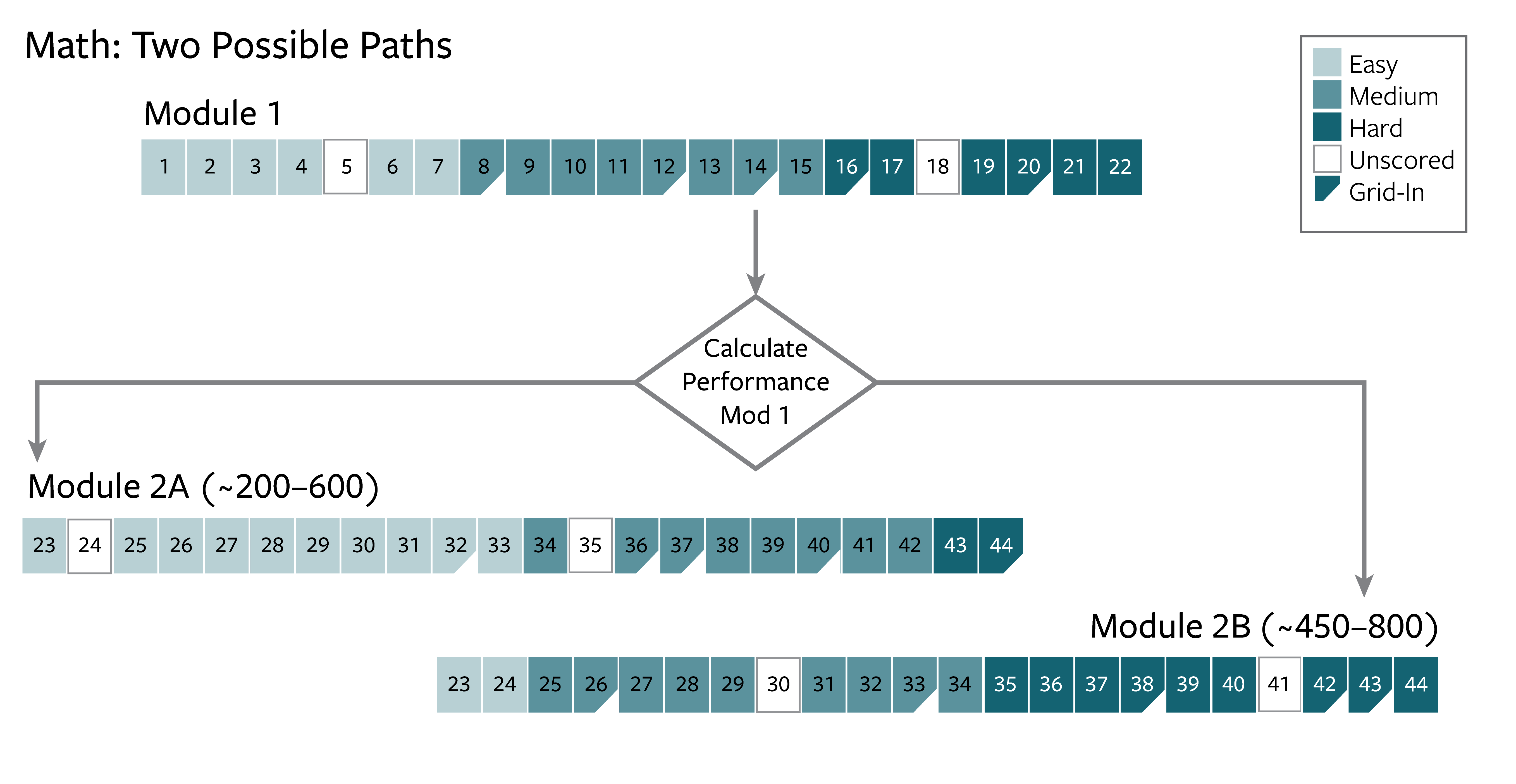
Stage Adaptive, The Technicalities
- A simple right/wrong tally does not make sense on an adaptive test, which means students will never find out how many questions they got correct or incorrect. Students will not know exactly how their score was determined. A published scale makes little sense when everyone has taken a different exam.
- Students will not be given access to their problems, because College Board will re-use some problems in the future. In lieu of releasing 3 actual tests per year via the Question-and-Answer Service (QAS), additional sample tests will roll out periodically.
- Practice testing will increase in importance, because it will be the only time students receive real feedback on their performance.
- Two questions per stage are unscored, equating questions. They will not be counted toward the calculation that determines which second stage the student receives nor will they be counted toward the overall score. College Board includes these questions to gather student performance data so that they can be included in future tests. Previously, this was handled by a fifth section that was easily identifiable as an “experimental” section. Students will not know which questions are unscored.
- College Board is using Item Response Theory (IRT) to scale the exams. Questions can have different weights under IRT, so a score is no longer determined by a simple count of right and wrong answers. IRT allows College Board to account for the fact that each student receives a different exam. It can produce an optimized picture of which problems and weightings best place a student into a particular score range, but it is a more complicated model. From a student’s perspective IRT is invisible. A student should simply concentrate on getting as many questions right as possible within the allotted time.
Test Security & Technology
- Students testing together will encounter differing versions of the test, even on the first stages. The test draws from a large pool of problems to create unique modules for each student. The created sets of problems will meet the same content standards and provide an equivalent experience for all test takers.
- The risk of a test being compromised is greatly reduced—no more locked drawers, sealed booklets, or mail delays.
- Students at the same site can be started at different times, since there is a greatly reduced risk of sharing problems within a room or during breaks.
Testing Experience

- Students will bring their own laptop or tablet or use the equipment provided by the school or site. They can also incorporate external devices such as a mouse, keyboard, or stylus for personal comfort. College Board will establish lending programs for students who do not have approved devices.
- The test will be administered in a locked-down app; students will not be able to open other applications while testing.
- Students will be expected to arrive with fully charged devices and the testing app pre-installed. Test centers *may* provide power to standard-timed examinees and *must* provide it to those with extended time.
- Scratch paper will be provided because, for example, the app will not allow for marking-up of math diagrams. Either a pencil or pen can be used for notes.
- The fact that students end at different times may create disruptions, although College Board maintains that its pilot testing has gone smoothly.
- If a power issue interrupts the test, it can be restarted with a proctor authorization. Deliberately powering down and firing up again is forbidden and considered cheating. Cheating tactics that try to exploit the digital form factor are unlikely to work, as College Board effectively has a full transcript of what occurred.
- Students will have their own timer in the app, so the problem of mistiming by proctors or the lack of notifications should be eliminated. The timer can be hidden up until the final 5 minutes of each stage.
- Students can move back and forth among questions, but only within the currently active stage.
- The app includes built-in features like a highlighter, answer eliminator, and question flag to help students track their progress through questions and identify questions that need further review. The highlighter is not available on the Math section.
Test Content and Question Format
College Board’s position is that scores on the paper SAT and digital SAT are interchangeable because the underlying content is not changing. However, there are some significant differences between the new and old exams.
Reading and Writing
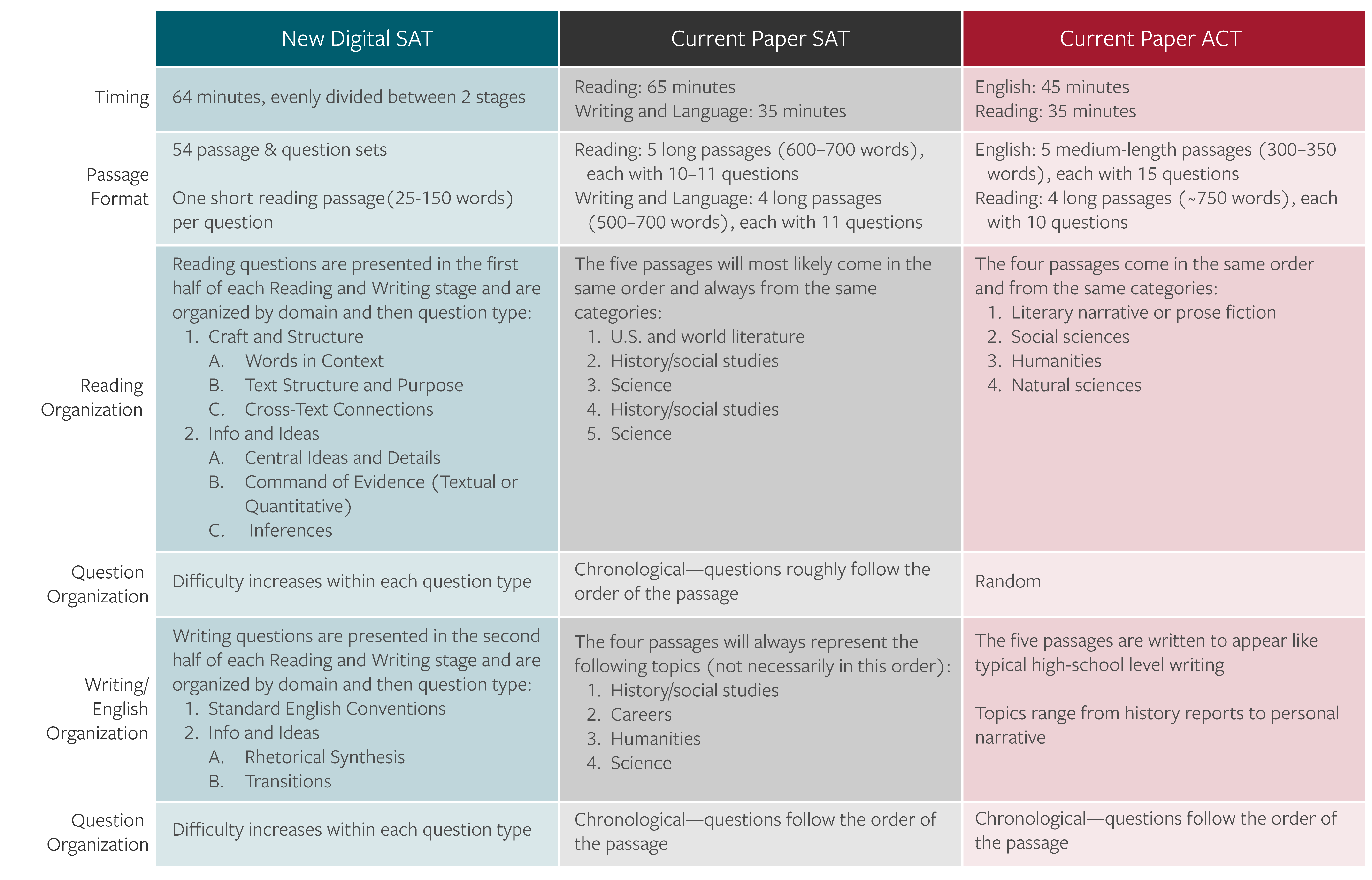
Key Changes
- Instead of two discrete sections, reading and writing have been combined. Students will see questions intermingled.
- Reading passages are much shorter (25-150 words) with one question per text instead of 11 questions alongside a long passage (600-700 words).
- “Great Global Conversation” as a reading passage type has been removed. Poetry has been added.
- Questions about graphics—tables, bar graphs, line graphs—have been simplified for digital devices.
- Writing questions will no longer test commonly confused words or idiomatic phrases.
- The “No Change” option in writing questions is removed.
Sample Reading Questions
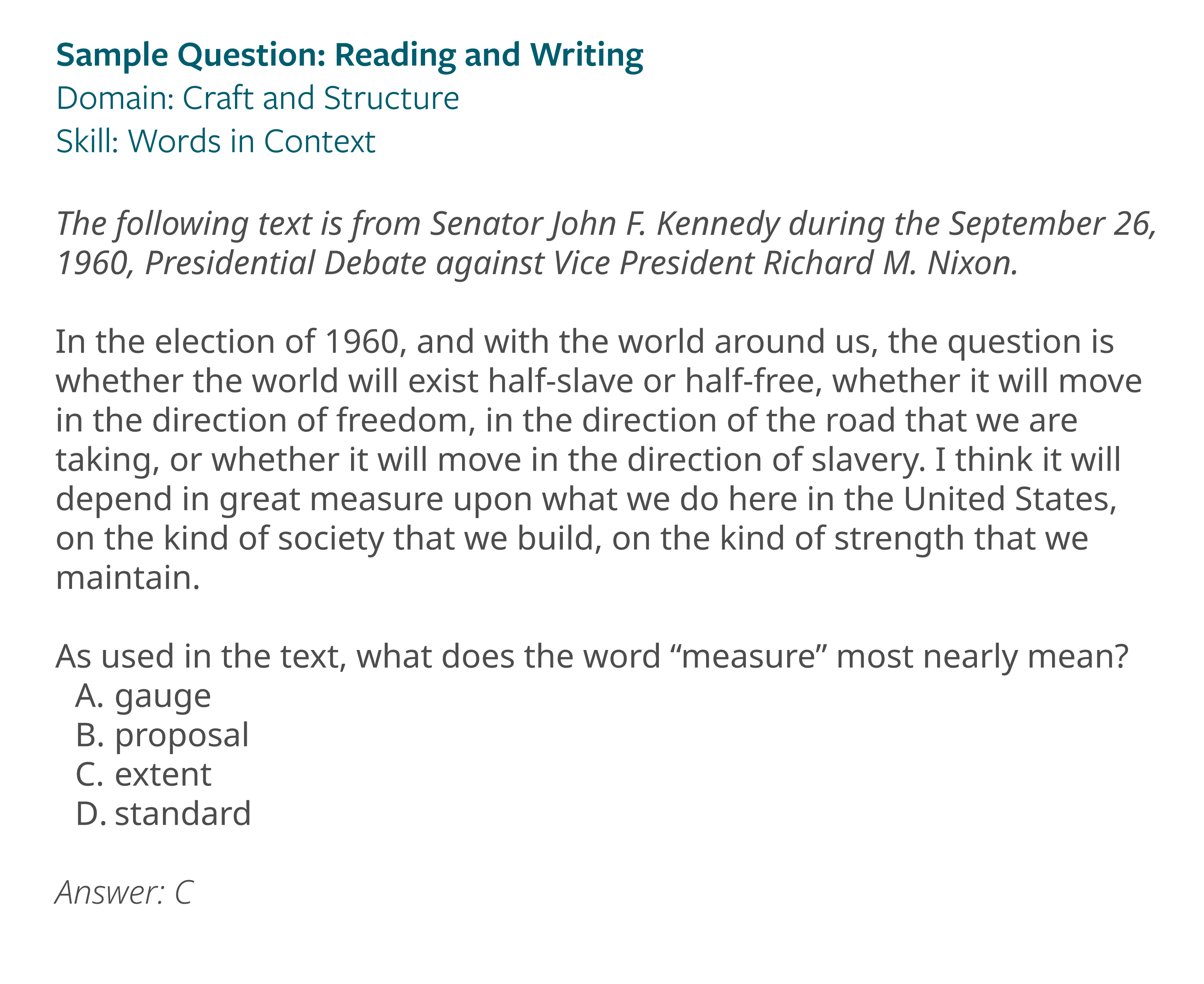
This example demonstrates the dramatically reduced length of SAT reading passages.
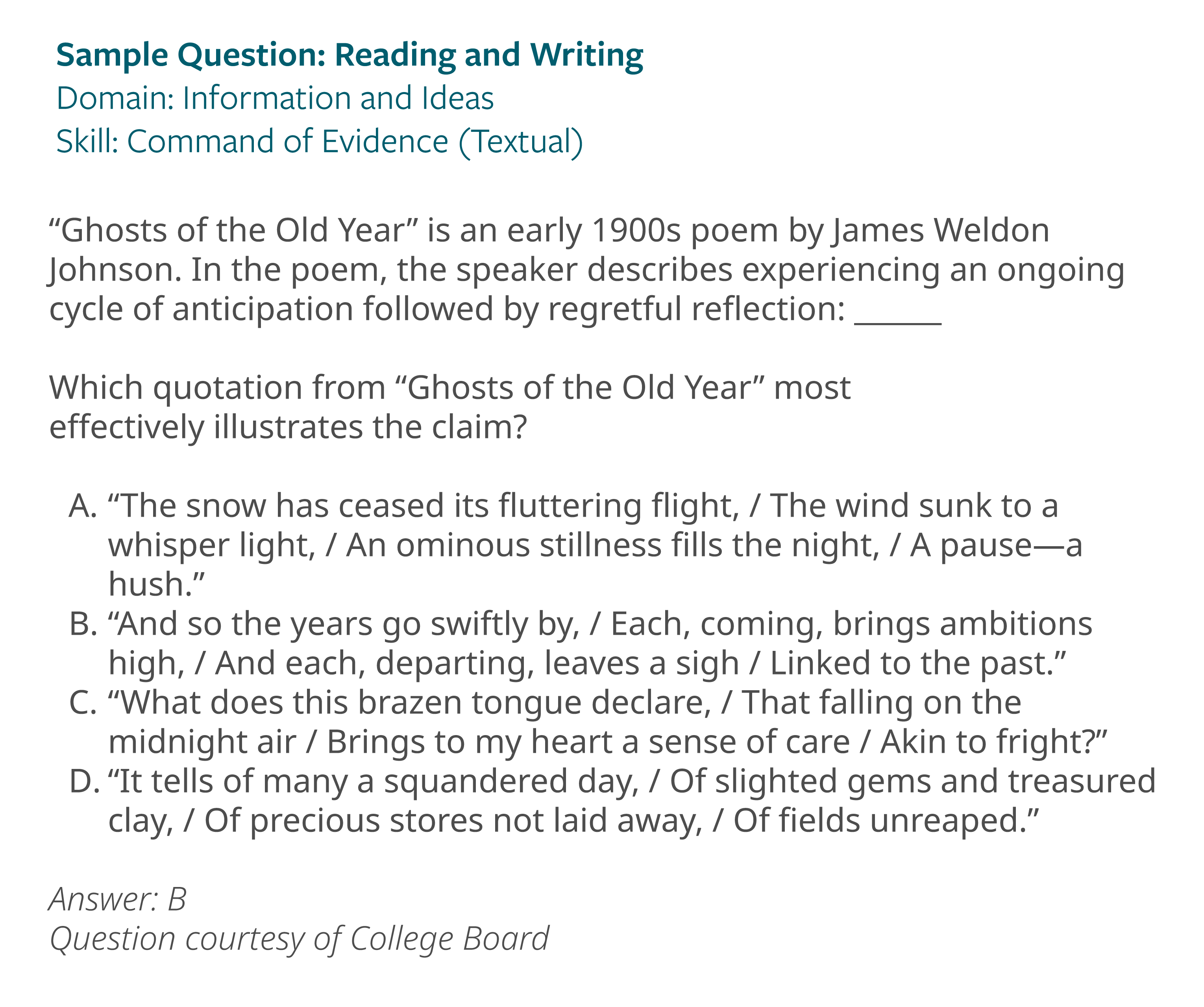
Sample Writing Questions

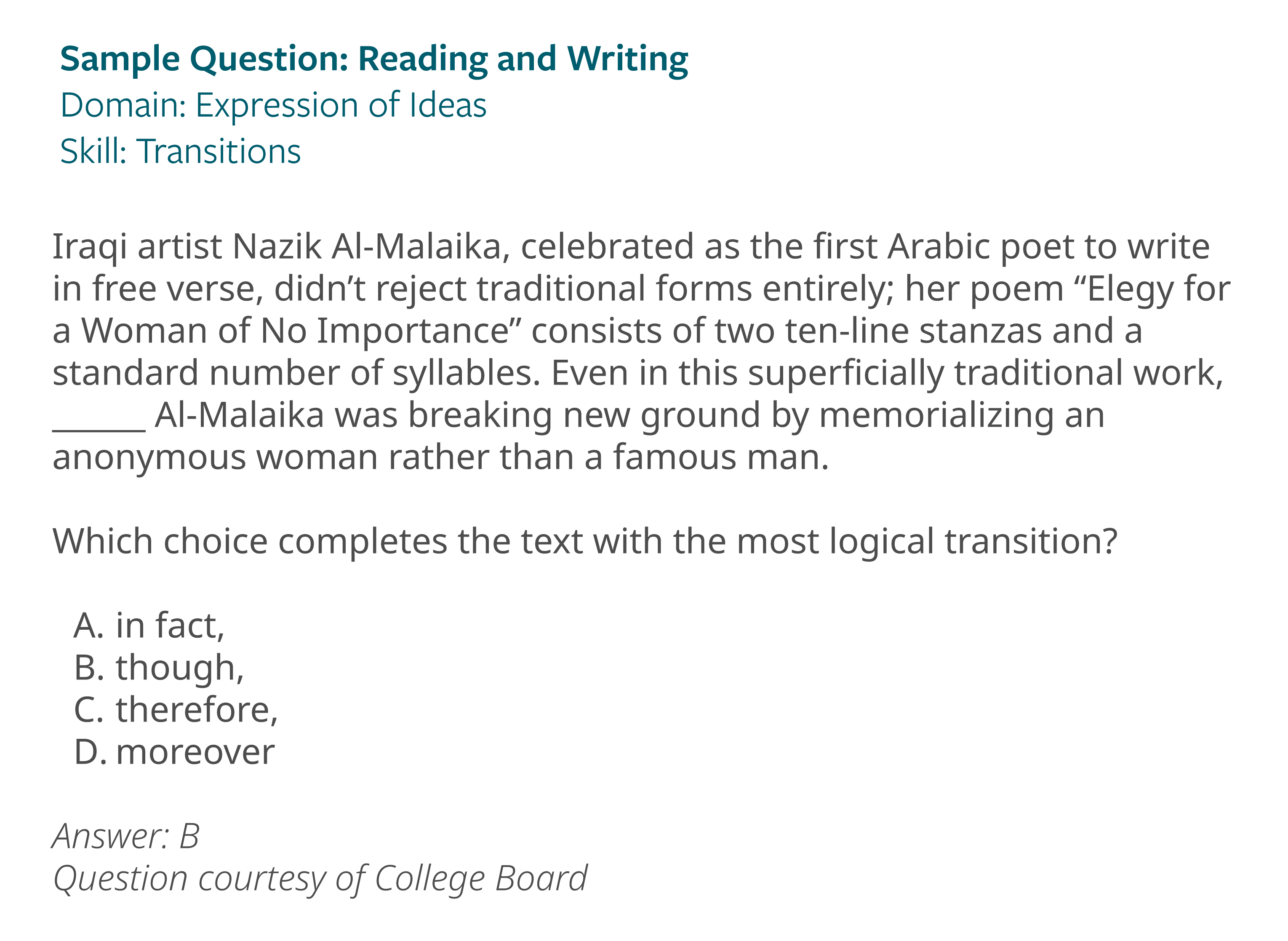
Math
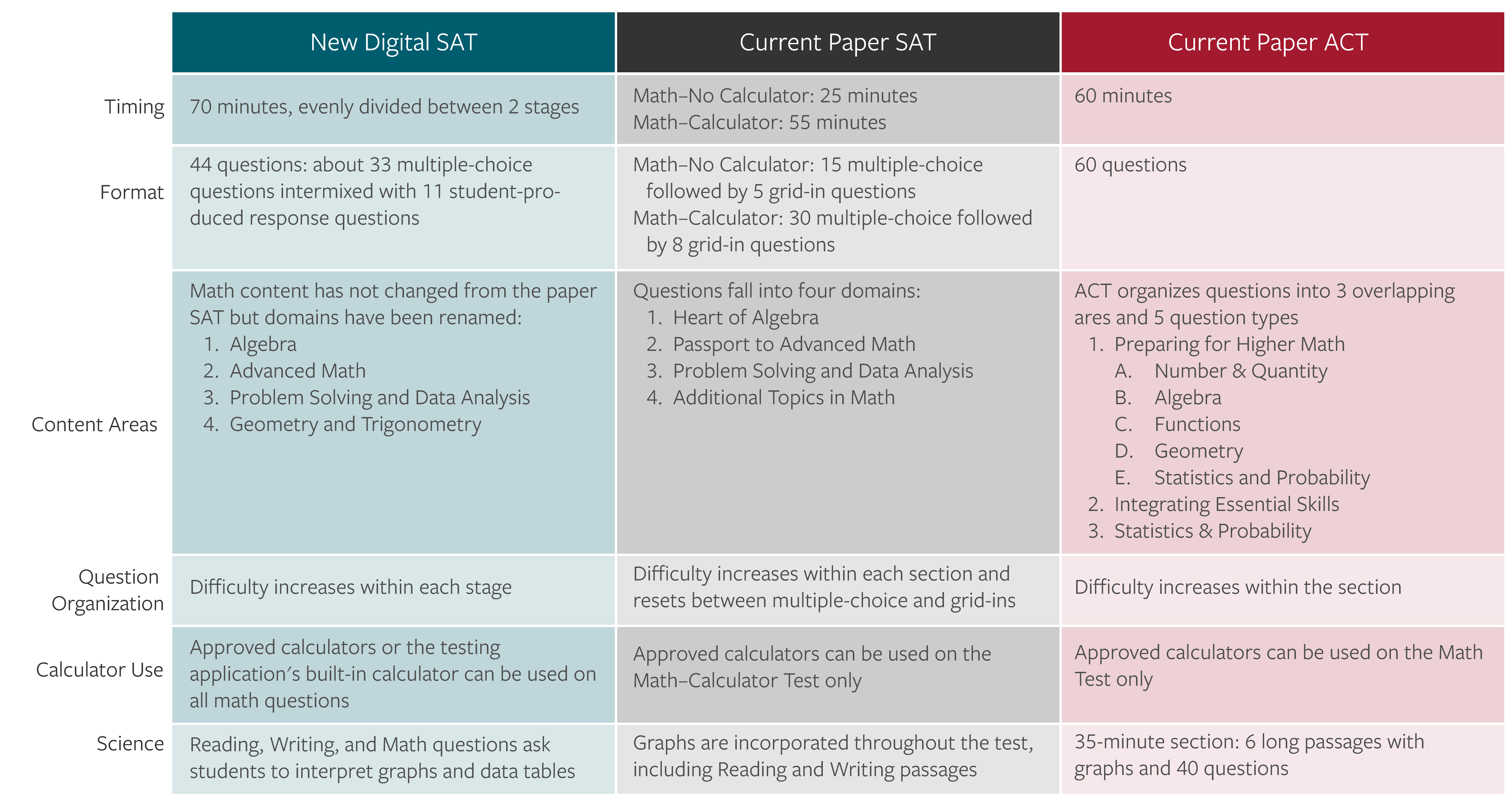
Key Changes
- Imaginary or complex numbers are no longer tested.
- Student-Produced Responses can now be negative (and in that case include an extra digit).
- There are no question sets with common info—every question is now discrete.
Sample Math Questions
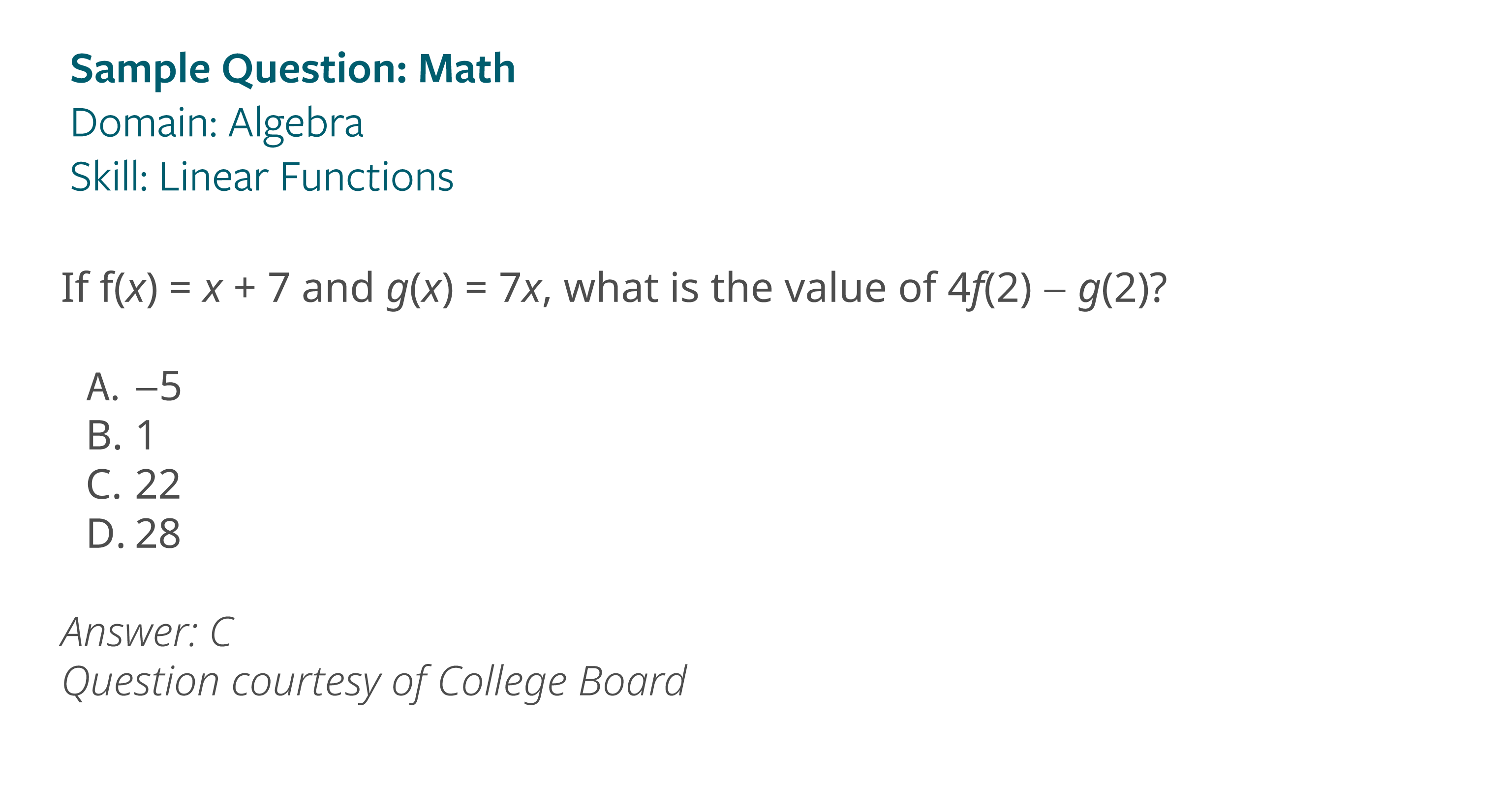
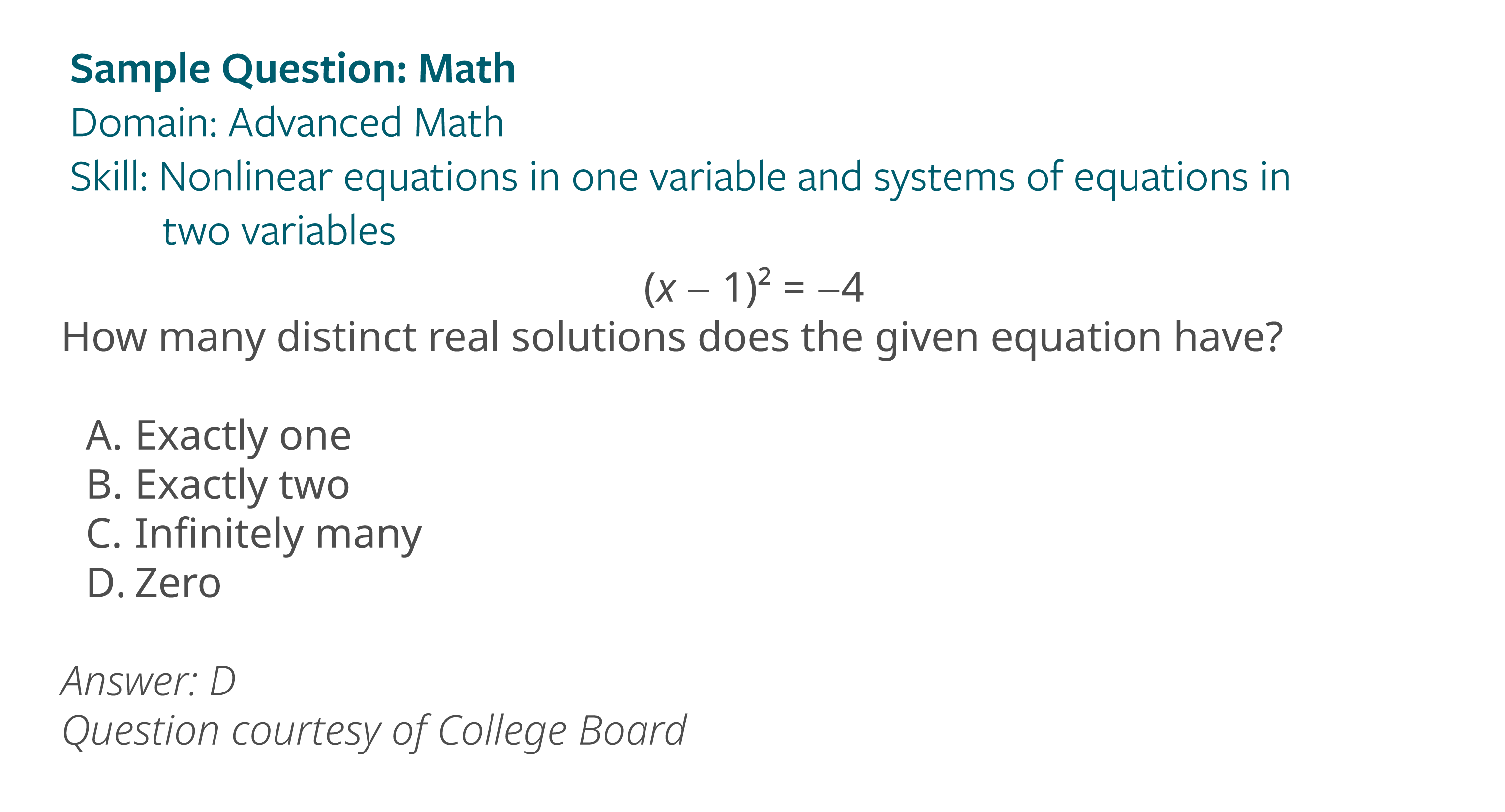
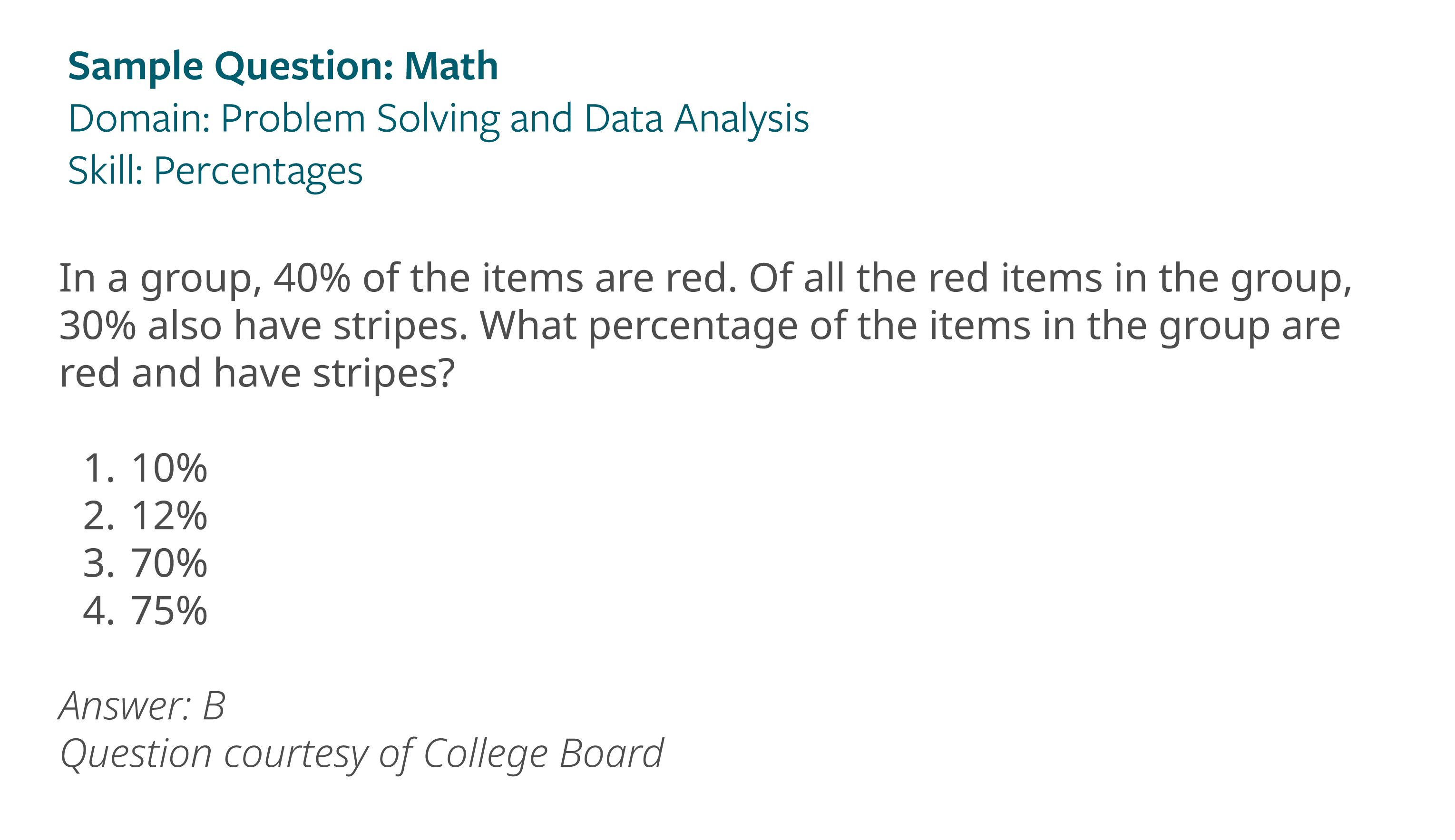
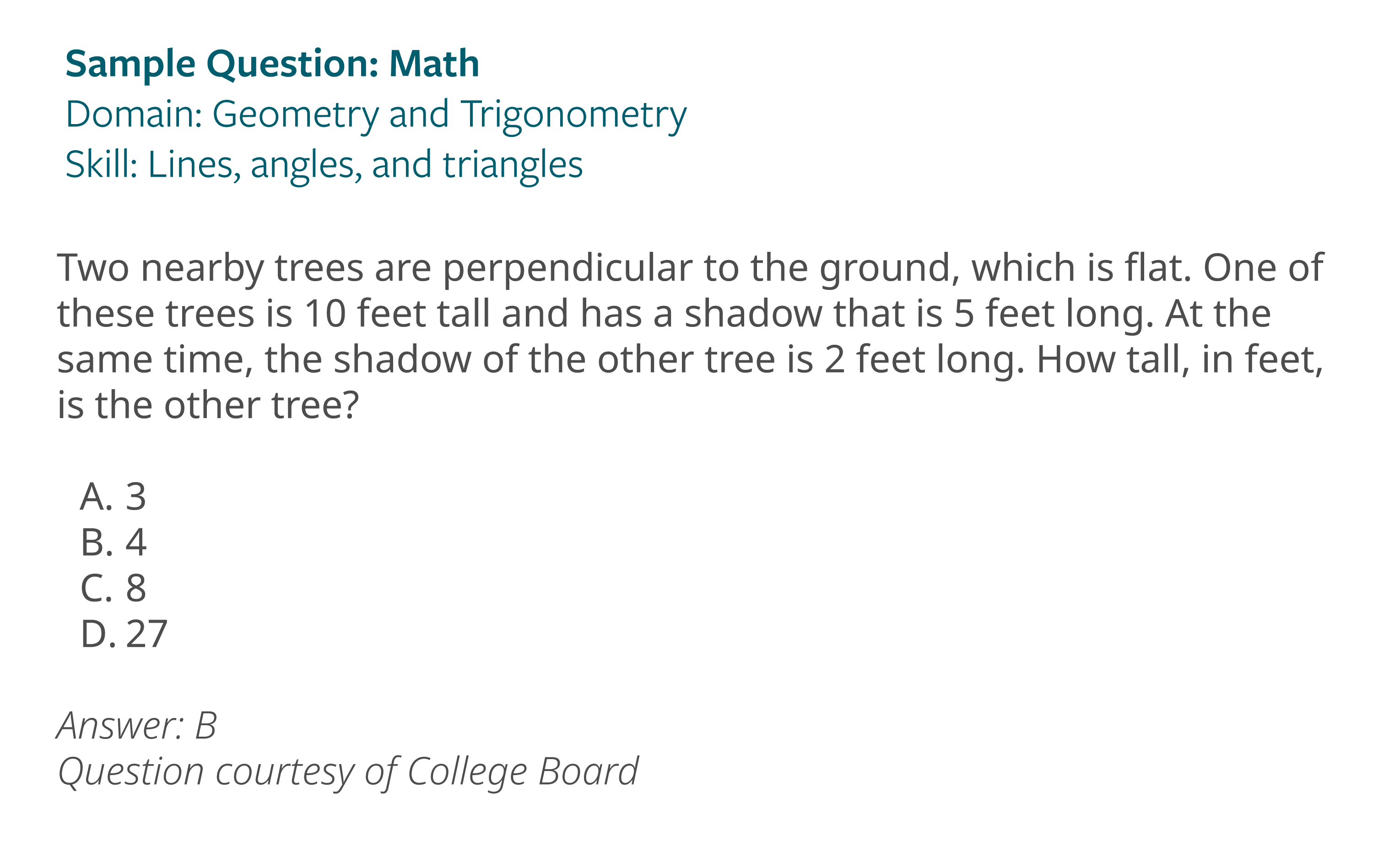
Responses and Updates from ACT:
- ACT wants to continue to be seen as the steady, reliable option, since the new digital SAT will be the third different SAT offered in just the last 8 years. The ACT has not had a major overhaul in more than 30 years.
- However, ACT is also surveying stakeholders on their thoughts regarding a shorter exam.
- One way of shortening the test — eliminating Science — has been rejected as an option.
- The optional Writing section will remain to comply with state contracts and for students testing internationally.
- Section Retesting is off the table for now.
- Digital testing at national sites is being considered and they are still working through logistical questions with their site partners. Paper exams will remain available even if a digital option is someday provided to all students at national sites.
- ACT already offers a digital test abroad and in special administrations domestically, but it is just a version of the paper exam for the computer.
- ACT has not ruled out adaptive scoring for a revised digital exam.
- Test site shortage—especially in regions like California—is a known problem with no clear strategic solution. Where ACT has strong traction with state and district testing, it’s less problematic.
- Both ACT and College Board are succeeding with school day testing, but with the unintended effect of reducing the incentive for those schools to also participate in national testing.
(Updated October 2023)

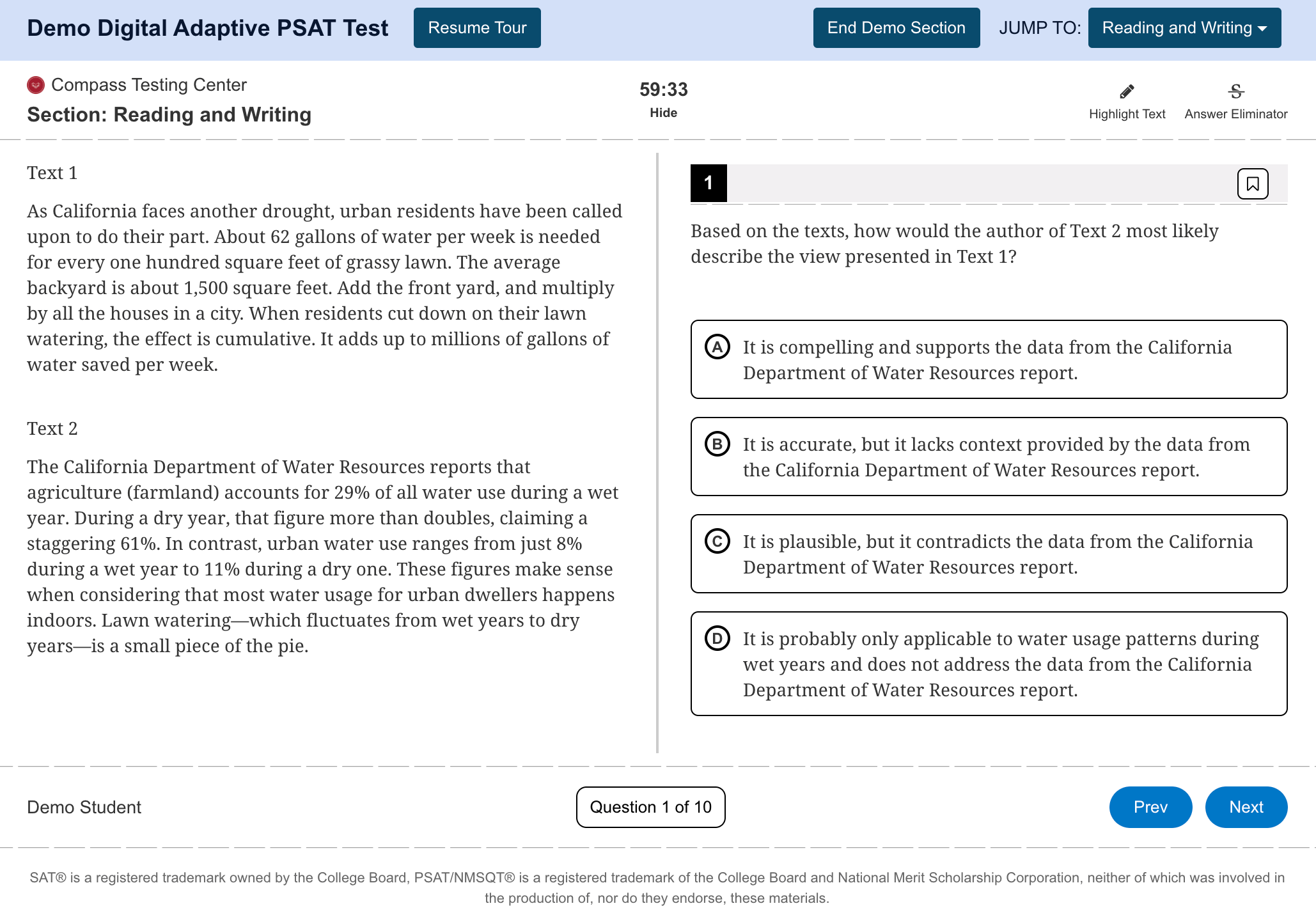
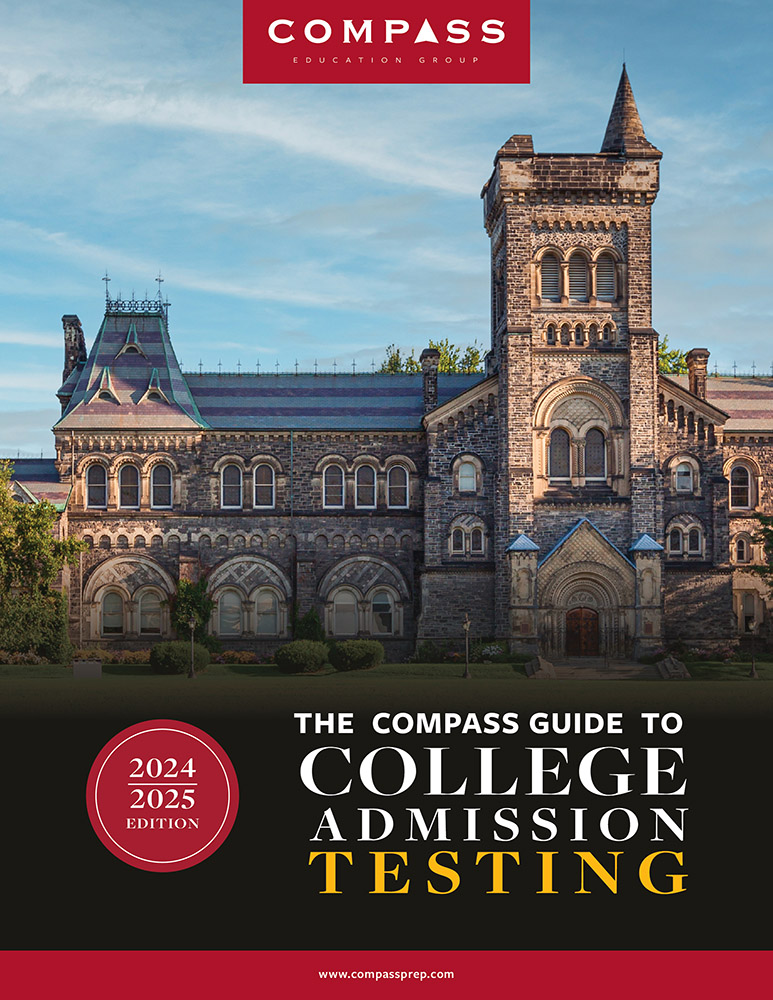
Thank you for helping me make sense of this significant news and continuing to be my go-to source for expertise in testing.
Thanks for the helpful summary of these changes Adam.
Thank you. This is extremely helpful.
You’re welcome, Ev. Thanks for reading!
If a student takes the new digital version during this week’s SAT school test date but has already taken a paper SAT and will take paper SAT this summer, will the new digital version still be incorporated into a superscore? For example if a student has a 700 score on the first paper SAT and then does 750 on the new digital version during school, will the superscore allow for the 750?
Nathalie,
That’s an excellent question. Other than making recommendations, College Board has no say in superscoring — it’s completely up to colleges. It’s still too early to know what colleges will choose to do. I’m confident that they will accept digital SAT scores, but less certain about whether they will superscore paper-and-pencil with digital. When the SAT changed 6 years ago, the overhaul was so extensive and the scoring changed enough that old and new scores were not superscored. College Board has made the case that the changes this time do not represent that sort of discontinuity and, I’m sure, will be encouraging colleges to accept scores interchangeably. We just don’t know enough about what colleges will choose to do.
The digital SAT is being offered in a limited pilot this period, and it sounds like your student is in that pilot. Would it be OK for me to reach out to you via email to find out more about how the experience goes? Thank you!
Nathalie,
I should have mentioned that there is a good chance that your student is not taking the new digital SAT but rather a computer-based version of the current SAT. Those have been around for some time, and some schools offer them during school day testing. That exam is considered the same as any other SAT score, so it would be superscored by colleges just the way a paper-and-pencil exam would be.
My daughter will be in the situation where she may have a score from both the new and the old SAT test . She wants to start preparing next summer 2023 for the SAT . Truly isn’t fair that it switches in to the new SAT in the Spring. Lets say she takes the test summer/ fall 2024 then wants to take again in the spring , it will be the new test! Are you saying colleges probably won’t superstore them the new with the old!
Amy,
It’s always unfortunate that when these overhauls happen some students get stuck in the middle.
It’s wonderful that your daughter will be ready to test in fall 2023. College Board has found that most students start in the spring, which is why they chose Dec/Mar as the split. I’d encourage you to see the upside. First, prep done for the paper SAT is not wasted. Many (most?) of the skills are transferrable. Math, in particular, will be very familiar. Second, it’s an opportunity for your daughter to get a shot at a test on which she might do better. As an analogy, many high-scoring students take both the SAT and ACT. While most will fall in the same range on the two exams, some students outperform on one or the other. We may see the same thing with the digital SAT and paper SAT. Not every student can do better on the digital SAT, because that would be addressed during the equating process. Some students will do better on paper. Some will do better on digital. Your daughter will be in the position of having taken both. The best of all worlds will be if colleges do decide to superscore. I think we’ll see a split, but I’m hesitant to guess the percentages. Some schools will be comfortable with College Board’s claim that the scores are interchangeable. Some schools will not be.
Thanks for this very helpful and easy to understand summary. Any chance you could make it available as a downloadable pdf? Thanks again.
Jodi,
Glad to hear that you found it helpful. A PDF is definitely in the works, but we’d like to wait for the official specs to be released so that all of the information is 100% accurate. College Board has been known to work in last minute revisions. We will be sure to provide a link once the PDF is ready.
Do you know if the actual content for english and math will be the same?
Hi Mike,
We just updated this article with more detailed information. Give it another read for a deep-dive into that question!
Compass provides another great resource, full of incredibly helpful info for students and parents. One minor typo you may want to correct—in the “Differences Between the New Digital SAT and Paper Tests: Overview” table, change the second “Combined R&W Stage 1” to “Combined R&W Stage 2.”
Thank you, Mike. We’ve fixed that table!
Are you sure about the fact that there are 4 unscored qs because i just knew it here from you guys is it official? And if i answered the unscored q correct my score wont be good because i would have mistakes in scored qs?
James,
Each stage has 2 unscored questions, and there are two Reading/Writing stages and 2 Math stages. That is official. The unscored questions have no impact on your score no matter how you answer them.
Do you have any information for how the digital PSAT might be changed? I have three students who have successfully achieved commended or semi-finalist. And my fourth will have her junior year psat in Fall 2023 with what looks like will be the digital version. Will it be the same set up as the SAT only adjusted down for the PSAT? I had held out hope that nothing would change through December 2023, but your article makes it appear that we should definitely switch to digital prepping. She is doing khan academy, but from what I have seen over there their test prep is still geared to the paper exam. Math is still calculator/no calculator.
Louise,
The new PSAT will be more similar to the new SAT than the current exams are to one another. They will be the same length in both time and questions. The PSAT will be slightly easier and will continue to have a RW score of 160-760 and Math score of 160-760. Khan does have some digital SAT materials available. When your student navigates to the digital SAT section of the site, she should say that she is outside of the U.S. Otherwise Khan assumes that she should still be prepping for paper-and-pencil. College Board has also published several exams with its Bluebook testing app available on computer or iPad.
For Math or for English there’s Modules 2A and 2B would my score be any different if, for example, I scored the same amount of questions correctly in both Modules?
Emily,
Because the questions in Module 2B are harder than those in 2A, you can get fewer correct and end up with the same score.
Regarding the equating questions, you write: “Previously, this was handled by a fifth section that was easily identifiable as an “experimental” section.” Doesn’t that describe the GRE, though? I’ve never heard of the current (non-digital) SAT having a fifth section.
Marc,
College Board presents an additional 20-minute section (RW or M) to a portion of students in order to test out new problems.
How does this new digital test format work with “breaks as needed” testing accommodations? It seems that the clock timer is controlled remotely than by a proctor.
Kim,
Testing is done via College Board’s official Bluebook app. The timer is under the student’s control. If the student has the appropriate accommodation, they can pause the test for breaks.
This is how our daughter’s October 2023 digital PSAT worked with “breaks as needed” (medical accommodations). The school was very helpful in providing 1-1 testing, at our request.
Is there any difference between the new PSAT and the digital SAT?
Sam,
Virtually none. The timing and structure are identical. The PSAT questions are slightly easier to match with the 160-760 scale. And you won’t find circle problems on the PSAT Math.